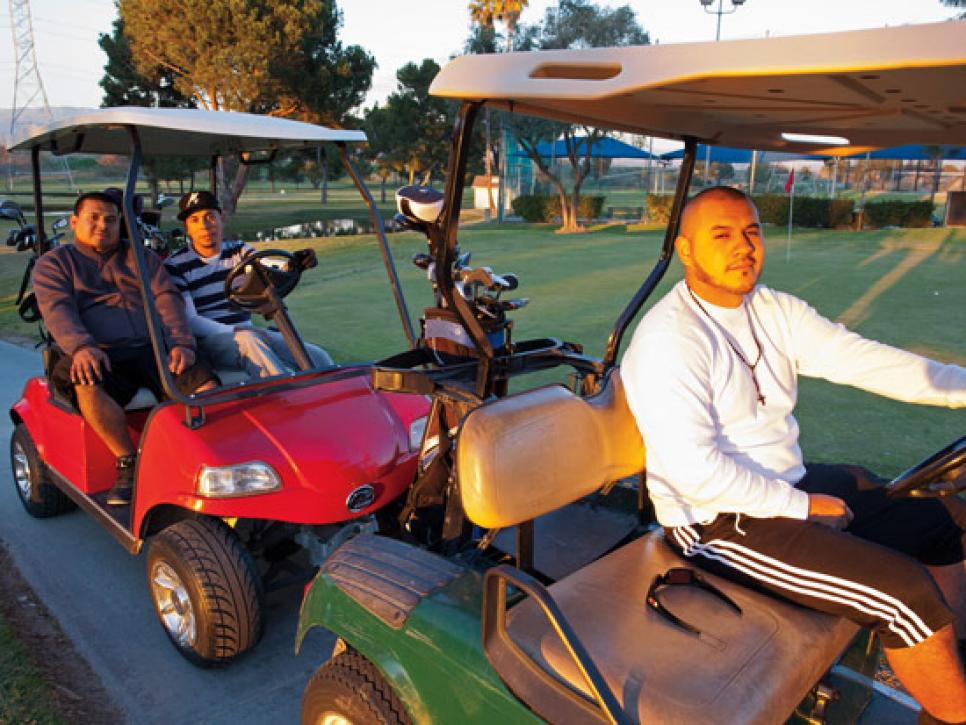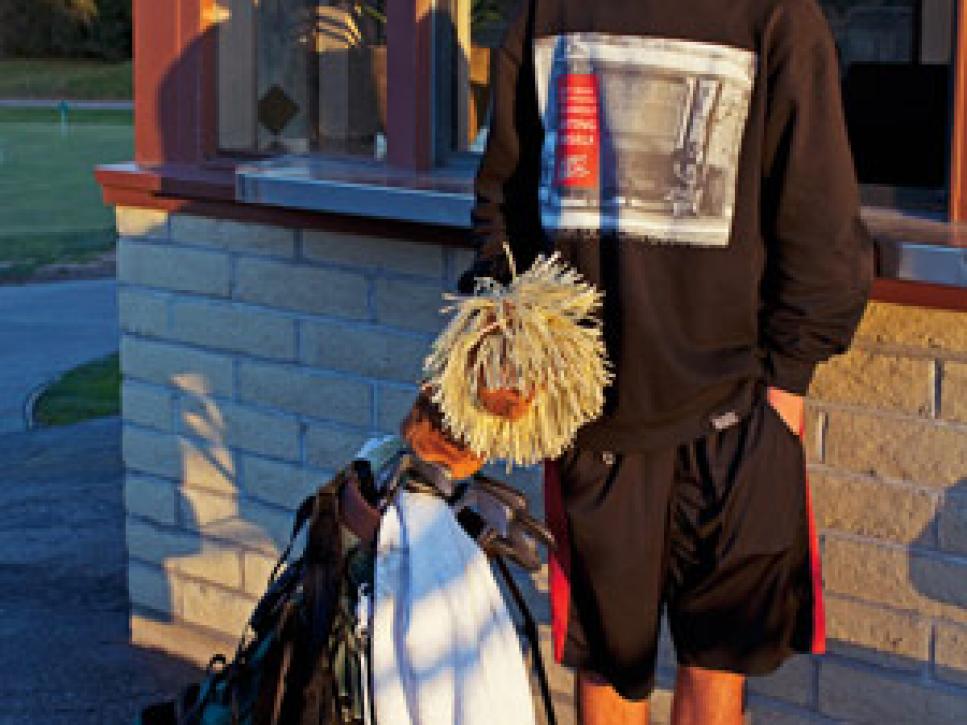A New Way In East L.A.

PICO TRIO: Carlos Avalos and Jose Manzo line up behind Rudy Ortega.
As expected, the breakfast burrito at Pico Rivera Golf Club
is excellent. But if you want to eat like locals, order menudo and a coffee. Served in a bowl of spicy red chili broth, this dish of chopped cow stomach is best garnished with raw onion and is a known cure for a hangover.
The nine-hole course, 1,500 yards, par 29, with an average green fee of $9, is wedged into a triangle of grass between a man-made embankment and a river restrained by concrete. You can't see over the bank, but about 10 miles to the southeast, as the crow flies or a person dares, is Compton, the infamous hood that became an icon of violence and survival from the lyrics of its homegrown rap stars Dr. Dre, Ice Cube, Coolio and others. But forget Compton. This is "Pico," and its Latino gangsters have their own stories, some of which involve golf.
"This is neutral ground," says James Ochs, the 27-year-old director of golf who draws from a community that is nearly 90 percent Latino. "On busy days I've had to pair members from different gangs, but it's not a problem." Ochs recognizes the tattoos. He also recognizes that unlike ink, human beings can change, and that taking up golf is often a sign. He's quick to learn the names of all patrons and ask about their games, even if their reputations precede them.
Which isn't to suggest this muny is unsafe. Any given day—or night under the lights—the course and practice range are also filled with young boys, teenage girls, grandmothers, anyone who wants to swing. Flip-flops, gym shorts, gold chains, birdies or quadruple bogeys—not much raises an eyebrow here. "So many Latinos don't really have an idea of what golf culture is, so the course just becomes an extension of the home," says Azucena Maldonado, founder of the Latina Golfers Association, which runs events in Southern California to introduce women to the game. Most of her participants have never heard of Lorena Ochoa. "They perceive golf as a network and a way to move up in their careers" but then get hooked by the more primary elements, like flush contact and fresh air. And with Latinos, Maldonado says, "When the mother's playing, the whole family's playing."

Like electric cars or eating local, "growing the game" is a fun idea that's easier to say than do. "There are so many programs out there that are just bullshit," says Larry Taylor of GolfLinks, the two-man firm that took over management of the course in 2012. "A club buses in a couple dozen inner-city teens for a clinic on a random Monday and the members pat themselves on the back, but in the end, that doesn't actually get kids playing golf."
Taylor's rule is that residents under 18 play for free except during school hours. A large bucket of range balls costs them only a dollar, a discount of $7. The Southern California Golf Association, which runs tournaments and fundraisers, gladly reimburses the course $2.50 for each youth green fee and bucket (this summer's tally by los jovenes was 474 rounds and 909 buckets). GolfLinks' incentivized contract with the city, Taylor believes, could serve as a model for munys everywhere. He and his partner are paid $6,000 a month to operate the course and share in net profits above a certain threshold.
"A course that doesn't let kids play for free is missing the boat," Taylor says. "You'll get more green fees from their parents and relatives, and you're building supply for the future."
Fifty thousand rounds were played at Pico Rivera in 2012, and the projection for 2013 is 55,000. Earlier records don't exist. When the course was built in 1965, a vocal group decried the limited appeal such an activity would have for its citizens, thereby wasting an already scarce resource, parkland. By the early 1980s, the course had devolved to "a place where people would go to drink and fight. That they had golf clubs in their hands was an afterthought," says David Gomez, a 10-handicapper and a videographer for the Los Angeles Police Department.
"I saw a dude get knocked out right there, cold," another regular tells me, pointing at the fifth green.
In 2007, a half-mile from the course entrance, a woman was shot and killed after she flashed her headlights in an attempt to stop the spray-painting of a wall. As of the fall of 2011, the course had its own "tags" of graffiti, dandelions growing in the bunkers, threadbare range mats for teeing grounds, bathrooms like highway gas stations', and had operated at a loss of $1 million over the previous four years.
"We didn't want to shut the course down, but it was a possibility," says Mike Matsumoto, the city's financial manager, who says the payroll had probably grown bloated with some employees who didn't know or care much about golf. The city interviewed several golf-management firms that each offered a variant of operating the course for a flat fee. One proposed upgrading the course so that it could be a destination for more serious golfers and charge higher green fees. "But we just didn't feel that would be much benefit to the community," Matsumoto says. When GolfLinks took over on Jan. 1, 2012, it cleaned house, dismissing the cashiers who received health and pension benefits and a grounds crew that had steadily accrued salary despite mowing greens haphazardly. Taylor got rid of the two rusty vending machines, the partition that separated customers from the cash register, the old posters covering the golf-shop windows, and for those not properly attired, a rental-shirt policy that charged a fee for a faded, and usually smelly, cotton polo. "No chipping, no tank-tops—I took down every sign that said no," Taylor says. Perhaps most important, Taylor kept Ochs, whose energy and dynamism Taylor believed would make up for a lack of head-pro experience or PGA teaching credentials.
Besides four grounds-crew workers, Ochs is the only full-time employee. For a golf pro, his story is improbable. He's the oldest of five children, and one sister was put up for adoption when their parents decided they couldn't afford to keep her. He attended 11 schools and recalls the family sleeping in a car during the interims their truck-driving father had to figure out life again. During stable years, James and Chante, his one friend who wasn't embarrassed to be a golfer, would ride their bikes to Pico Rivera. James stuck with golf, but Chante ultimately succumbed to gangs, prison and drugs before death at age 27.
Ochs has instituted as many junior clinics, teams, lessons and events as can fit on a calendar. "I want to give kids a place to come, and use golf to teach that we live with the consequences of our decisions." Compared with the former era of governmental bureaucracy, Ochs loves the speed and autonomy with which he now operates. Taylor says, "I gave James the keys to the car and told him to come back for gas money whenever he wants."

"I am beyond impressed with how they've turned this course around," says Sandra Gonzalez, director of the city's parks and recreation.
The regulars appreciate the newly mowed collection areas that give the holes definition, and, as Gomez says, "It seems like the caliber of people has changed." Gomez is proud of his son, Stephen, who besides whipping Dad, works part-time as a starter and youth instructor.
Fernando Ortiz has been a golfer exactly as long as his two sons, which is four months. "I've never seen Jayden [9] and Jordan [13] so into anything," says Ortiz, whose boys asked to learn after watching the movie "Happy Gilmore." "It's been amazing, all the friends we've made in so little time," he says.
For 2013, the golf course will profit about $120,000, which is still $60,000 shy of unlocking bonus money for GolfLinks. "A nine-hole course will never be a huge moneymaker," Taylor says, "but we've eliminated the city's liability of a big loss."
Can golf change a community? That's too broad a claim for any set of data on crime, income and wellness to make. Since the clubhouse's renovation, it has become the de facto venue for community meetings. "If you want citizens who respect rules and don't feel rewarded by aggressive behavior, there's really only one sport you'd choose," Taylor says.
Does the pace of play ever get glacial here? Sometimes. But hush up and eat your menudo. Maybe it's not what you're used to, but it's healthy and doesn't cost much.